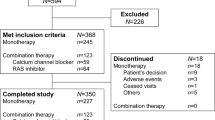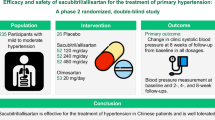Abstract
The relationship between the increase in blood pressure and the incidence of cardiovascular disease is well recognized today. Studies have shown that more attention should be paid to systolic blood pressure (SBP) in relation to cardiovascular risk and that therapeutic interventions should preferably focus on reducing SBP. The antihypertensive efficacy of indapamide 1.5 mg sustained release (indapamide SR), a low-dose thiazide-type diuretic, was assessed on SBP. Three randomized, double-blind, controlled studies were conducted with indapamide SR, over a period of 3 to 12 months. Elderly patients or patients with target-organ damage, hypertension and left ventricular hypertrophy (LVH) (LIVE study) or with type II diabetes with microalbuminuria (NESTOR study) showed a decrease in SBP varying from 22.7 to 31.8 mmHg. The treatment with indapamide SR resulted in a better or equivalent control of SBP than treatment with a standard dose of a true thiazide diuretic (hydrochlorothiazide), a calcium channel blocker (amlodipine), and an angiotensin-converting enzyme inhibitor (enalapril). No therapeutic escape was observed. All treatments showed good acceptability with no unexpected adverse event. In conclusion, indapamide SR is very effective in lowering SBP—a major independent cardiovascular risk factor—notably in hypertensive high-risk patients with LVH, the elderly and diabetics, when compared to major antihypertensive treatments. This SBP-lowering effect is maintained over the long term.
This is a preview of subscription content, access via your institution
Access options
Subscribe to this journal
Receive 12 digital issues and online access to articles
$119.00 per year
only $9.92 per issue
Buy this article
- Purchase on Springer Link
- Instant access to full article PDF
Prices may be subject to local taxes which are calculated during checkout



Similar content being viewed by others
References
Kannel WB . Blood pressure as a cardiovascular risk factor: prevention and treatment. JAMA 1996; 24: 1571–1576.
Kannel WB, Stokes JLL . Hypertension as a cardiovascular risk factor. In: Bulpitt CJ (ed). Hand Book of Hypertension. Epidemiology of Hypertension. Elsevier Science: Amsterdam, 1985, pp 15–34.
Sagie A, Larson MG, Levy D . The natural history of borderline isolated systolic hypertension. N Engl J Med 1993; 329: 1912–1917.
Black HR . The paradigm has shifted to systolic blood pressure. Hypertension 1999; 34: 386–387.
Lewington S et al. Age-related relevance of usual blood pressure to vascular mortality: a meta-analysis of individual data for one million adults in 61 prospective studies. Lancet 2002; 360: 1903–1913.
Black HR et al. Baseline characteristics of the 16 605 patients in the CONVINCE study [Abstract]. J Hypertens 1999; 17: S201.
Cushman WC et al. Blood pressure control in the Antihypertensive and Lipid Lowering Treatment to Prevent Heart Attack Trial [Abstract]. Am J Hypertens 1998; 11: 17A.
Safar ME, London GM . The arterial system in human hypertension. In: Swales JD (ed). Textbook of Hypertension. Blackwell Scientific: London, 1994, pp 85–102.
Nichols WW, O'Rourke M . McDonald's Blood Flow in Arteries. Theoretical, Experimental and Clinical Principles, 4th edn. E. Arnold: London, Sydney, Auckland, 1998, pp 54–113, 201–222, 284–292, 347–401.
Franklin SS et al. Haemodynamic patterns of age-related changes in blood pressure. The Framingham Heart Study. Circulation 1997; 96: 308–315.
Systolic Hypertension in the Elderly Program Cooperative Research Group. Prevention of stroke by antihypertensive drug treatment in older persons with isolated systolic hypertension: final results of the Systolic Hypertension in the Elderly Program (SHEP). JAMA 1991; 265: 3255–3264.
Somes GW et al. The role of diastolic blood pressure when treating isolated systolic hypertension. Arch Intern Med 1999; 159: 2004–2009.
Franklin SS et al. Is pulse pressure useful in predicting risk for coronary heart disease? The Framingham Heart Study. Circulation 1999; 100: 354–360.
Millar JA, Lever AF, Burke V . Pulse pressure as a risk factor for cardiovascular events in the MRC mild hypertension trial. J Hypertens 1999; 17: 1065–1072.
Blacher J et al. Pulse pressure—not mean pressure—determines cardiovascular risks in older hypertensive patients. Arch Med 2000; 160: 1085–1089.
Domanski MJ et al. Isolated systolic hypertension, prognostic information provided by pulse pressure. Hypertension 1999; 34: 375–380.
Chobanian AV et al. Seventh report of the Joint National Committee on Prevention, Detection, Evaluation, and Treatment of High Blood Pressure. Hypertension 2003; 42: 1206–1252.
2003 European Society of Hypertension. European Society of cardiology guidelines for the management of arterial hypertension. J Hypertens 2003; 21: 1011–1053.
Morgan T, Lauri J, Bertram D, Anderson A . Effect of different antihypertensive drug classes on central aortic pressure. Am J Hypertens 2004; 17: 118–123.
Donnelly R . Clinical implications of indapamide sustained release 1.5 mg in hypertension. Clin Pharmacokinet 1999; 37(Suppl 1): 21–32.
Ambrosioni E et al. Low-dose antihypertensive therapy with 1.5 mg sustained-release indapamide: results of randomised double-blind controlled studies. European study group. J Hypertens 1998; 16: 1677–1684.
Emeriau JP, et al., European Study Investigators. A comparison of indapamide SR 1.5 mg with both amlodipine 5 mg and hydrochlorothiazide 25 mg in elderly hypertensive patients: a randomized double-blind controlled study. J Hypertens 2001; 19: 343–350.
Leonetti G et al. Evaluation of long-term efficacy of indapamide SR 1.5 mg in elderly hypertensive patients. Am J Hypertens 2001; 14(Part 2): P221.
Marre M et al. Equivalence of indapamide SR and enalapril on microalbuminuria reduction in hypertensive patients with type 2 diabetes. The NESTOR study. J Hypertens 2004; 22: 1613–1622.
Marre M et al. The extent of microalbuminuria reduction with indapamide SR in elderly hypertensive type 2 diabetic patients. The NESTOR study. J Hypertens 2003; 21(Suppl 4): S183.
Gosse P et al. Regression of left ventricular hypertrophy in hypertensive patients treated with indapamide SR 1.5 mg vs enalapril 20 mg: the LIVE study. J Hypertens 2000; 18: 1465–1475.
Gosse P et al. Centralized echocardiogram quality control in a multicenter study of regression of left ventricular hypertrophy in hypertension. J Hypertens 1998; 16: 531–535.
Du Cailhar G et al. Dietary sodium and pulse pressure in normotensive and essential hypertensive subjects. J Hypertens 2004; 22: 697–703.
Avolio AO et al. Effects of aging on changing arterial compliance and left ventricular load in a northern Chinese urban community. Circulation 1983; 68: 50–58.
Et-Taouil, Schiavi P, Levi BI, Plante GE . Sodium intake, large artery stiffness, and proteoglycans in the spontaneously hypertensive rat. Hypertension 2001; 38: 1172–1176.
Benetos A et al. Arterial stiffness, hydrochlorothiazide and converting enzyme inhibition in essential hypertension. J Human Hypertens 1996; 10: 77–82.
London G, Schmieder R, Calvo C . Applanation tonometry: arterial mechanical properties of indapamide SR vs candesartan and amlodipine: the X-CELLENT tonometry study. J Hypertens 2004; 22(Suppl 2): S116.
Contri MB et al. Dose-dependent prevention of fibrosis in aorta of salt-loaded stroke-prone spontaneously hypertensive rats by combined delapril and indapamide treatment. J Cardiovasc Pharmacol 2002; 40: 388–398.
Ambrosioni E, Veronesi M . Clinical role of Natrilix SR in the treatment of at-risk hypertensive patients. J Hypertens 2003; 21(Suppl 1): S13–S17.
Weidmann P . Metabolic profile of indapamide sustained release in patients with hypertension. Data from three double blind studies. Drug Safety 2001; 24: 1155–1165.
Author information
Authors and Affiliations
Rights and permissions
About this article
Cite this article
London, G. Efficacy of indapamide 1.5 mg, sustained release, in the lowering of systolic blood pressure. J Hum Hypertens 18 (Suppl 2), S9–S14 (2004). https://doi.org/10.1038/sj.jhh.1001799
Published:
Issue Date:
DOI: https://doi.org/10.1038/sj.jhh.1001799



